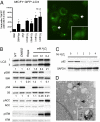ATM signals to TSC2 in the cytoplasm to regulate mTORC1 in response to ROS
- PMID: 20160076
- PMCID: PMC2840158
- DOI: 10.1073/pnas.0913860107
ATM signals to TSC2 in the cytoplasm to regulate mTORC1 in response to ROS
Erratum in
- Proc Natl Acad Sci U S A. 2012 May 22;109(21):8352
Abstract
Ataxia-telangiectasia mutated (ATM) is a cellular damage sensor that coordinates the cell cycle with damage-response checkpoints and DNA repair to preserve genomic integrity. However, ATM also has been implicated in metabolic regulation, and ATM deficiency is associated with elevated reactive oxygen species (ROS). ROS has a central role in many physiological and pathophysiological processes including inflammation and chronic diseases such as atherosclerosis and cancer, underscoring the importance of cellular pathways involved in redox homeostasis. We have identified a cytoplasmic function for ATM that participates in the cellular damage response to ROS. We show that in response to elevated ROS, ATM activates the TSC2 tumor suppressor via the LKB1/AMPK metabolic pathway in the cytoplasm to repress mTORC1 and induce autophagy. Importantly, elevated ROS and dysregulation of mTORC1 in ATM-deficient cells is inhibited by rapamycin, which also rescues lymphomagenesis in Atm-deficient mice. Our results identify a cytoplasmic pathway for ROS-induced ATM activation of TSC2 to regulate mTORC1 signaling and autophagy, identifying an integration node for the cellular damage response with key pathways involved in metabolism, protein synthesis, and cell survival.
Conflict of interest statement
The authors declare no conflict of interest.
Figures






References
-
- Hartwell LH, Kastan MB. Cell cycle control and cancer. Science. 1994;266:1821–1828. - PubMed
-
- Elledge SJ. Cell cycle checkpoints: Preventing an identity crisis. Science. 1996;274:1664–1672. - PubMed
-
- Kastan MB, Lim DS. The many substrates and functions of ATM. Nat Rev Mol Cell Biol. 2000;1:179–186. - PubMed
-
- Kastan MB, Bartek J. Cell-cycle checkpoints and cancer. Nature. 2004;432:316–323. - PubMed
-
- Schneider JG, et al. ATM-dependent suppression of stress signaling reduces vascular disease in metabolic syndrome. Cell Metab. 2006;4:377–389. - PubMed
Publication types
MeSH terms
Substances
Grants and funding
- R01 DK124709/DK/NIDDK NIH HHS/United States
- R01 CA21765/CA/NCI NIH HHS/United States
- CA16672/CA/NCI NIH HHS/United States
- R01 GM062694/GM/NIGMS NIH HHS/United States
- R01 CA063613/CA/NCI NIH HHS/United States
- P30 CA021765/CA/NCI NIH HHS/United States
- P30 ES007784/ES/NIEHS NIH HHS/United States
- R01 NS058956/NS/NINDS NIH HHS/United States
- R01 CA63613/CA/NCI NIH HHS/United States
- P30 CA016672/CA/NCI NIH HHS/United States
- ES007784/ES/NIEHS NIH HHS/United States
- P50 CA098258/CA/NCI NIH HHS/United States
- P01 HD18655/HD/NICHD NIH HHS/United States
- R01 CA71387/CA/NCI NIH HHS/United States
- P30 HD018655/HD/NICHD NIH HHS/United States
- R01 CA108941/CA/NCI NIH HHS/United States
- R01 CA071387/CA/NCI NIH HHS/United States
- R01 CA143811/CA/NCI NIH HHS/United States
LinkOut - more resources
Full Text Sources
Other Literature Sources
Molecular Biology Databases
Research Materials
Miscellaneous

